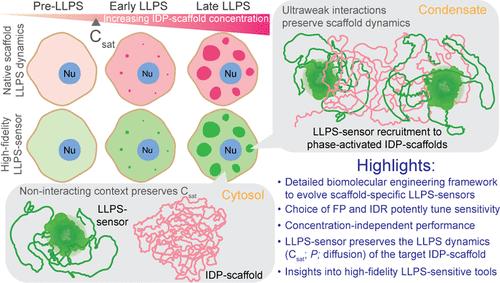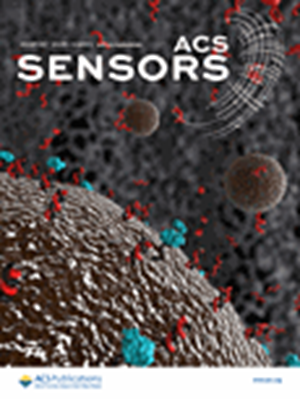Genetically-Encoded Phase Separation Sensors Enable High-Fidelity Live-Cell Probing of Biomolecular Condensates
IF 9.1
1区 化学
Q1 CHEMISTRY, ANALYTICAL
引用次数: 0
Abstract
Biomolecular condensates are membraneless compartments with enigmatic roles across intracellular phenomena. Intrinsically disordered proteins (IDPs) often function as condensate scaffolds, fueled by liquid–liquid phase separation (LLPS) dynamics. Intracellular probing of condensates relies on live-cell imaging of IDP-scaffolds tagged with fluorescent proteins. Conformational heterogeneity in IDPs, however, renders them uniquely susceptible to artifacts from tagging. Probing epidermal condensates in skin, we recently introduced genetically-encoded LLPS-sensors that circumvent the need for molecular-level tagging of skin IDPs. Departing from subcellular tracking of IDP-scaffolds, LLPS-sensors report on the assembly and liquid-like dynamics of their condensates. Here, we demonstrate biomolecular approaches for the evolution and tunability of epidermal LLPS-sensors and assess their impact in the early and late stages of intracellular phase separation. Benchmarking against scaffold-bound fluorescent reporters, we discovered that tunable ultraweak scaffold–sensor interactions uniquely enable the sensitive and innocuous probing of nascent and established biomolecular condensates. Our LLPS-sensitive tools pave the way for the high-fidelity intracellular probing of IDP-governed biomolecular condensates across biological systems.

基因编码相分离传感器使高保真活细胞探测生物分子凝聚物
生物分子凝聚体是无膜的隔室,在细胞内现象中具有神秘的作用。内在无序蛋白(IDPs)通常作为凝析支架,由液-液相分离(LLPS)动力学驱动。凝聚物的细胞内探测依赖于用荧光蛋白标记的idp支架的活细胞成像。然而,idp的构象异质性使它们特别容易受到标记的影响。探测皮肤中的表皮凝析物,我们最近引入了基因编码的llps传感器,该传感器绕过了对皮肤IDPs分子水平标记的需要。与idp支架的亚细胞跟踪不同,llps传感器报告了其凝析物的组装和液体动力学。在这里,我们展示了表皮llps传感器的进化和可调性的生物分子方法,并评估了它们在细胞内相分离的早期和晚期阶段的影响。通过对支架结合荧光报告的基准测试,我们发现可调的超弱支架-传感器相互作用独特地实现了对新生和已建立的生物分子凝聚物的敏感和无害探测。我们的llps敏感工具为跨越生物系统的idp控制的生物分子凝聚物的高保真细胞内探测铺平了道路。
本文章由计算机程序翻译,如有差异,请以英文原文为准。
求助全文
约1分钟内获得全文
求助全文
来源期刊

ACS Sensors
Chemical Engineering-Bioengineering
CiteScore
14.50
自引率
3.40%
发文量
372
期刊介绍:
ACS Sensors is a peer-reviewed research journal that focuses on the dissemination of new and original knowledge in the field of sensor science, particularly those that selectively sense chemical or biological species or processes. The journal covers a broad range of topics, including but not limited to biosensors, chemical sensors, gas sensors, intracellular sensors, single molecule sensors, cell chips, and microfluidic devices. It aims to publish articles that address conceptual advances in sensing technology applicable to various types of analytes or application papers that report on the use of existing sensing concepts in new ways or for new analytes.
 求助内容:
求助内容: 应助结果提醒方式:
应助结果提醒方式:


